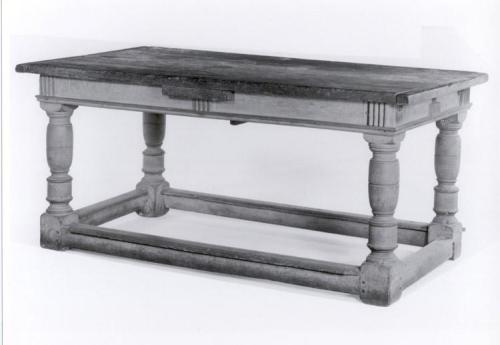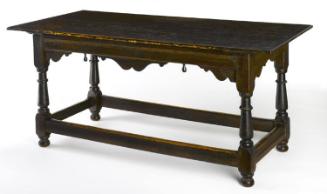Draw Table
Original OwnerOriginally owned by
Matthew Allyn
(American, 1605 - 1670)
Furniture MakerMade by
Unknown
Date1640-1660
MediumOak
DimensionsPrimary Dimensions (overall height x width x depth): 33 3/4 x 73 1/8 x 35 3/4in. (85.7 x 185.7 x 90.8cm)
ClassificationsFurniture
Credit LineBequest of Henry Halsey
Object number1876.3.1
DescriptionMassive oak draw table in the seventeenth century style. The removeable top is composed of four long boards that are joined at each end by a batten, or strip of wood. The top is supported by a frame with horizontal rails and stretchers that are joined at each end to the top and bottom of each leg post. Only one long side retains its complete decoration on the rail, which includes three applied blocks of wood; each block of wood has four vertical bands of molding, each consisting of a half circle flanked by a fillet. Below these applied ornaments is a narrow, applied, strip of molding across the full width of the table. The opposite rail has only one applied block (the center and right block are missing) and the applied strip of molding below. Each end of the table has three square holes in the frame, one through the top center of the rail and one through the inner edge of each leg post. The applied blocks of wood at each end of the table are shaped to accommodate these square holes (at one end one applied block is missing, at the opposite end both blocks are missing). Below the applied wood is a horizontal strip of molding (this strip is missing from one end of the table). Each turned leg post consists of a recessed area over a barrel-shaped center area, a cylindrical portion, and a square ankle (the feet are missing). Each leg is joined to the others with a stretcher, consisting of a horizontal span of wood with a wide, applied top that is finished at the each edge with a quarter circle. The table has an early red wash.
Condition: The draw leaves and corresponding supports are missing. The top is well worn and scratched. The feet are missing. Some applied blocks and molding are missing. There are dormant insect holes in the lower legs and stretchers. Portions of the molded edges of the top of the stretchers have broken off. At one time this molding extended around the ankle of each leg post; now only one leg post retains that molding. The early, but not original, red wash on the table is faded.
Design and Construction Details:
Top. The top is formed of four long, thick boards that are butted together. At each end of the top is a batten that is joined to the boards with wooden pins. A block of wood is nailed to the underside of one long side of the top. The underside of the top has two vertical, rectangular blocks of wood; these are joined to the underside of the top with a sliding dovetail at the outside center edge of the two center boards that form the top.
Frame. Each rail and stretcher is tenoned and double-pinned into the turned leg posts. The molded blocks and strips of molding are nailed to the rails and tops of the leg posts. The top of each stretcher is pinned to the riven wood below. The molding extends past the end of the stretcher to the front of the leg post (this feature is missing on all but one leg post).
NotesHistorical Note: The Dutch in Connecticut. In 1614, Dutch captain and explorer Adriaen Block discovered the Connecticut River. He sailed as far north as half way between Hartford and Windsor, then left the area. In 1622-23, Jacob van Corlaer purchased land in what is now the city of Hartford. A small fort was established, called the House of Good Hope, from which the Dutch traded fur and wampum with Native Americans. In 1633-34 the English founded Windsor and Wethersfield, to the north and south of the Dutch settlement. By 1636 Thomas Hooker acquired the title to the land around the river between Windsor and Wethersfield. Unlike the Dutch who primarily stayed for trade purposes, the English were intent on establishing settlements and cultivating the land. In the 1640s, as English settlements gradually confined the Dutch to the Hartford area, there was increasing tension between the Dutch and the English. In a 1650 treaty with the Commissioners of Massachusetts, Plymouth, Connecticut and New Haven, the Dutch were formally confined to the House of Good Hope. By 1654, with the English and the Dutch at war, the General Court in Hartford sequestered the fort. Shortly thereafter, the fort was closed, and the majority of the Dutch traders resettled in New York. (Hunt 1/12/2006)Condition: The draw leaves and corresponding supports are missing. The top is well worn and scratched. The feet are missing. Some applied blocks and molding are missing. There are dormant insect holes in the lower legs and stretchers. Portions of the molded edges of the top of the stretchers have broken off. At one time this molding extended around the ankle of each leg post; now only one leg post retains that molding. The early, but not original, red wash on the table is faded.
Design and Construction Details:
Top. The top is formed of four long, thick boards that are butted together. At each end of the top is a batten that is joined to the boards with wooden pins. A block of wood is nailed to the underside of one long side of the top. The underside of the top has two vertical, rectangular blocks of wood; these are joined to the underside of the top with a sliding dovetail at the outside center edge of the two center boards that form the top.
Frame. Each rail and stretcher is tenoned and double-pinned into the turned leg posts. The molded blocks and strips of molding are nailed to the rails and tops of the leg posts. The top of each stretcher is pinned to the riven wood below. The molding extends past the end of the stretcher to the front of the leg post (this feature is missing on all but one leg post).
Subject Note: A draw table is a table with additional leaves that may be drawn out to extend the length of the table top. The leaves are stored beneath the top when not in use. When they are extended, the each leaf is supported by sliding lopers that fit through openings in each end of the frame. This form first appeared in Europe in 1550 and was popular until the third quarter of the seventeenth century. Draw tables appear in seventeenth century American inventories. They were used for dining, in conjunction with stools, and may have been covered with a carpet when not in use. The form was revived in the twentieth century by French and American designers. (Hunt 12/1/2005)
Status
Not on view






